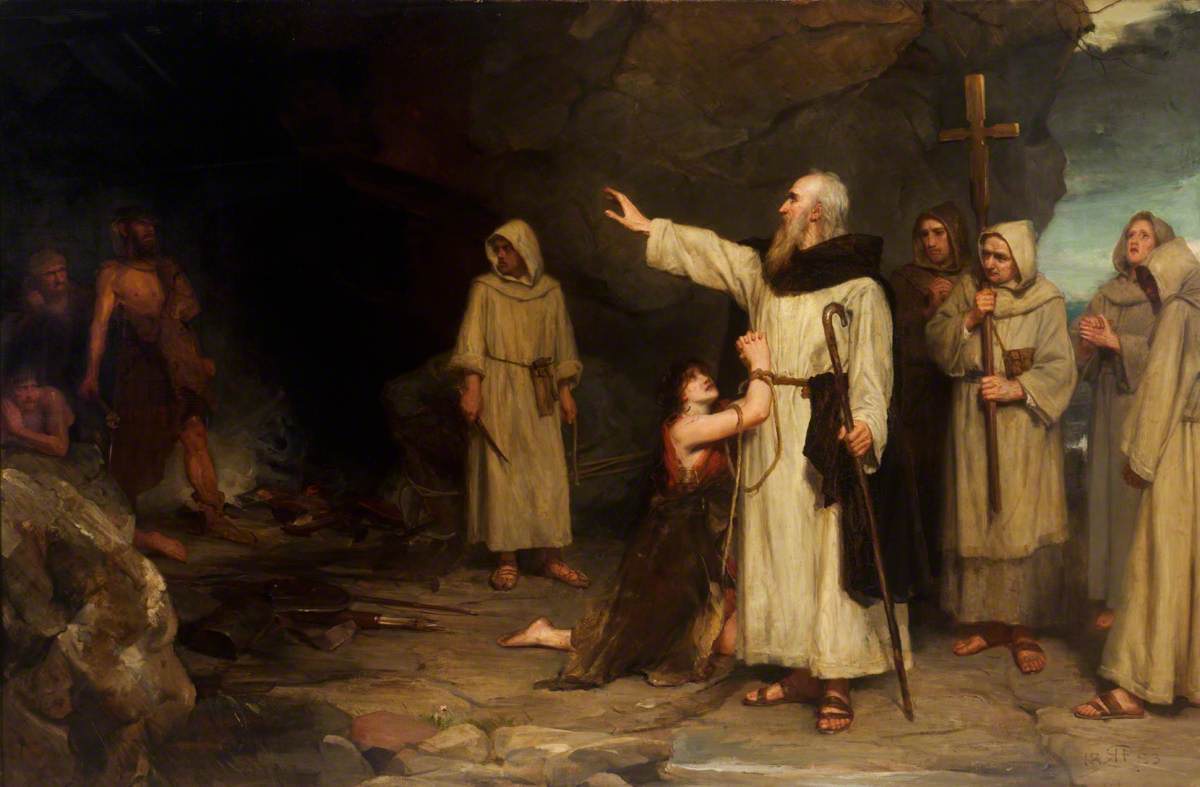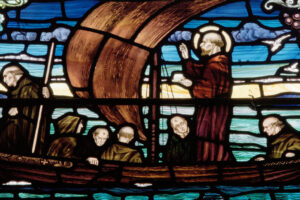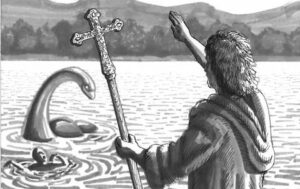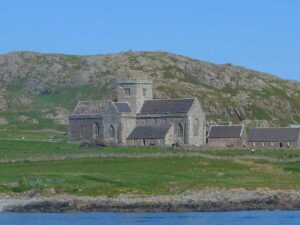
BORN TO ROYALTY
St. Columba was a missionary priest and abbot, known as the Apostle to the Picts. Columba was born to a Gaelic Irish royal family at Gartan in County Donegal in northern Ireland in the year 521. His parents were Phelim and Eithne, and the child was probably baptized Columb Cille, meaning “Dove of the church.” When he was a young child, the family lived at Glencolmcille, a village which was named in his honor. He was devoted to God even as a boy and was well-educated. As a teen, he attended the monastery school at Moville, where he was taught by its founder, [St.] Finnian of Moville. He was ordained a deacon before the age of twenty. He then went to Leinster, where he trained as a bard or composer/reciter of poetry. Lastly, he went to the acclaimed monastery at Clonard, learning under its abbot, [St.] Finnian of Clonard. He became a monk, and it is likely that he was ordained a priest while there.

SENT FORTH AS AN APOSTLE
At Clonard, Columba was part of a group of twelve trained by Finnian and sent out as apostles. During the subsequent fifteen years, Columba preached and labored to establish monasteries. New monasteries were established at Derry, Durrow, Kells, and Swords. Columba visited the tomb of St. Martin at Tours, France and returned with his copy of the Gospels, which he brought back to Derry for veneration.
When Curnan of Connaught, a kinsman who was fleeing from the tribal King Diarmaid, arrived at Columba’s doorstep seeking refuge, Columba took him in. The king’s men found him, however, and despite protective sanctuary laws, put the man to death. This set off a tragic battle between Columba’s clan and the King’s, causing the deaths of more than three thousand men.
A PENITENTIAL LIFE
Feeling responsible for this carnage and desiring to do penance, Columba in 563 sailed away from Ireland with a group of monks in a simple crude vessel. He intended to bring the message of salvation to an equal number of pagans as those who were lost in the battle. The group arrived at the island of Iona, a three by one-mile-long island off the southwestern coast of Scotland.
From there, Columba set about to convert the brutish Picts to the Faith. In this work, many miracles occurred at his behest. His work bore much fruit, and many people were converted, and in gratitude, ownership of Iona was granted to him. There, he built a monastery that was destined to become the most influential one in all Christendom for a time and the center of Celtic monastic life for all the British Isles. It was there that a school for missionaries was established, and it was the center of literacy and higher learning for the region. So highly regarded was Columba, he was appointed to be a mediator among quarreling tribes. Indeed, he was active in civic matters, most notably successfully campaigning to exempt women from military service.
Columba returned to Ireland several times in order to look after the monasteries he had previously established there and to establish a new monastery at Durrow. He spent the remainder of his years in Scotland, however, with the Iona monastery being his base and home. He founded numerous churches, both in the Scottish mainland and the Hebrides island chain. In his lifetime, he successfully converted vast numbers of souls in both Scotland and Northumbria.

MANY MIRACLES
Regularly accompanied by miraculous occurrences, in 565 Columba most notably cast a frightful water beast to the bottom of Loch (Lake) Ness – perhaps the fabled Loch Ness Monster. Columba was a brilliant man, evidenced by his extensive poetic writings, his transcription of the Gospels more than two hundred times, hymn writings, as well as hundreds of book transcriptions. The incredibly beautiful, illuminated manuscript of the Gospels known as the Book of Kells, written after his death, is a reflection of his influence. He died at Iona June 9, 597, while kneeling before the altar of the monastery chapel. He was approximately seventy-five years old.

Most of what we know about St. Columba is from the biography of a succeeding abbot at Iona, Adomnan, as well as the writings of St. Bede. St. Columba lived his life in penance. He could have remained in Ireland, where he likely would have become king of his clan. Instead, he lived a life of apostolic toil, with much fasting and long prayer vigils, and he routinely slept on the hard floor. He was a vigorous, tall man with a powerful voice and was recognized as a man of holiness and wisdom wherever he went. His influence in the area was immense in spreading Celtic Christianity. His monastery at Iona was renowned all over Europe for generations as a center of holy living and higher education; its monks spread throughout Europe to bring the Gospels to pagan peoples. Columba’s mortal remains were kept for a time at the Iona monastery, but are now venerated in Ireland’s County Down, where they rest with those of Sts. Patrick and Brigid, and the three of them are co-patrons of Ireland. In Ireland, he is known as St. Colmcille, and his feast day is June 9.
